I like to write out of doors. Sometimes I write when I’m sitting down by the lake, sometimes  just out on the deck. I occasionally address correspondence to friends and family in fountain pen ink, and strangely, the weather is not always on my side with some of these endeavors. Children—and some of you without any might find this hard to imagine—don’t always keep their distance from your handwritten masterpiece, when they’ve just fallen out of a kayak, and are standing around, drip-drying in otherwise glorious weather. Cats and liquid almost always means trouble. Children, cats, and liquids, I have found, can combine to result in events too improbable to imagine.
just out on the deck. I occasionally address correspondence to friends and family in fountain pen ink, and strangely, the weather is not always on my side with some of these endeavors. Children—and some of you without any might find this hard to imagine—don’t always keep their distance from your handwritten masterpiece, when they’ve just fallen out of a kayak, and are standing around, drip-drying in otherwise glorious weather. Cats and liquid almost always means trouble. Children, cats, and liquids, I have found, can combine to result in events too improbable to imagine.
On those rare occasions when my psychic faculties make my teeth itch, I opt for an ink that is supposed to be water-resistant in some way. Now, I have to choose my words carefully here, because—to me—a water-resistant ink should remain at least legible on the page after it gets wet. It shouldn’t just run into a smeary mess at the first drop of liquid, and a waterproof ink should be impervious. It should remain clear and legible, even if the page is floating, face-down, in my bath (don’t ask).
The trouble is, most people wouldn’t know how resistant is resistant, or how proof is waterproof, until they slosh a bit of Merlot over their journal, or it’s too late, disaster strikes, and the coffee cup is upended over their entire desk (really, don’t ask; or maybe just ask him in the picture above). So this week, I thought I’d take a look at the inks that I have bought, in the hopes that whatever I wrote with them, would still be legible in the pouring rain (I do send letters to England after all), or in the face of a liquid-based, possibly child/feline-related disaster.
Making a Decision
When you buy something fountain pen-related, there is usually plenty of help available to aid you in making the right decision. But in the case of buying inks based on their different attributes, it can get confusing. The usually excellent Goulet Pens, as ever, has a great ink selection tool, but in this case, it mostly helps you judge an ink by brand or color.
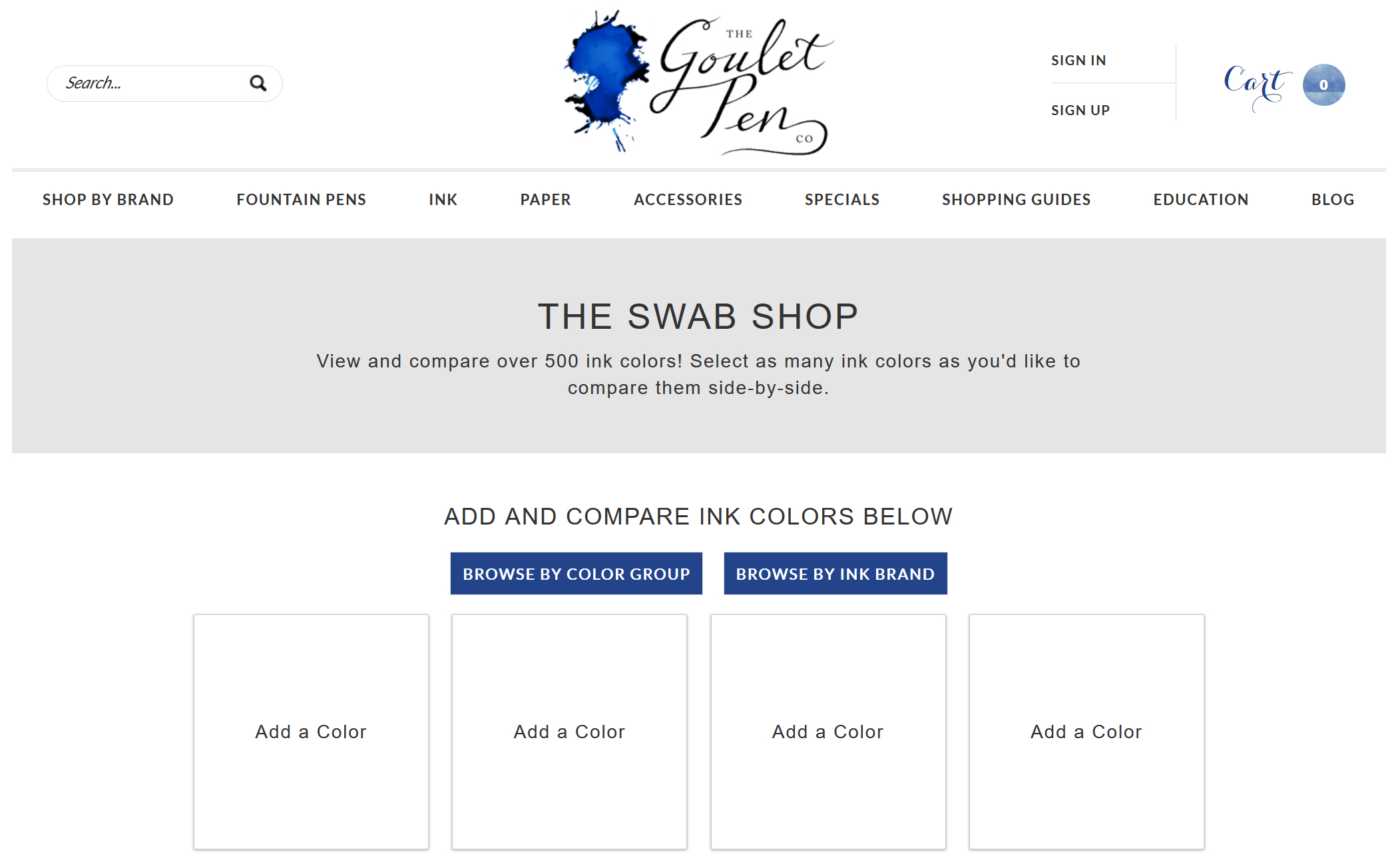
To find out about an inks’ water-resistant qualities (amongst others), you have to dig into the product description page. Or—in the case of Noodler’s inks—they link to a handy feature comparison chart. The only other really useful tool that I’ve found, that enables you to compare features of each ink (like water-resistance, and archival suitability) is the Anderson Pens Ink Comparison Tool.
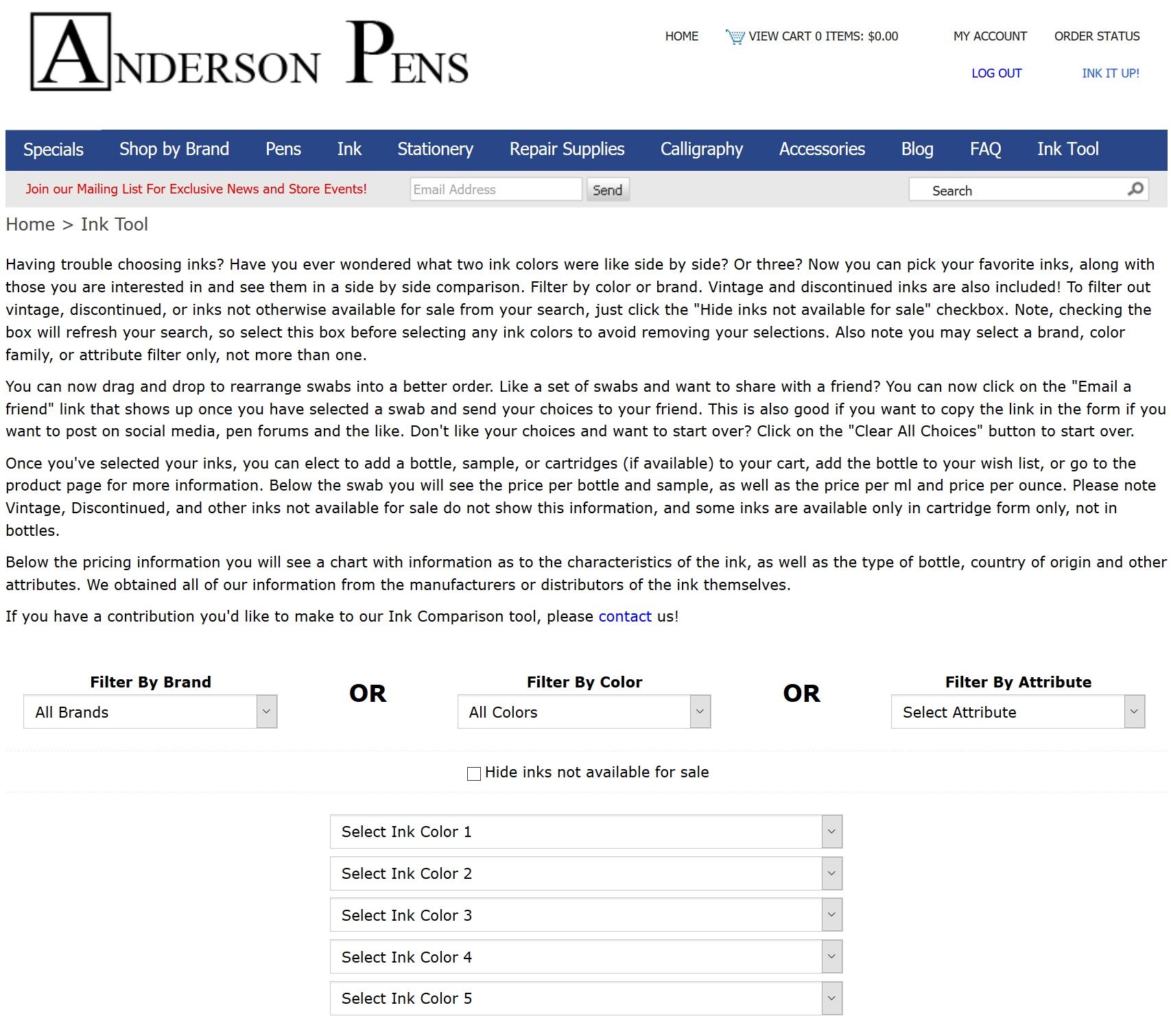 This is really useful, it lets you compare different brands, that each have specific attributes, side by side, then skip straight to their respective product pages for ordering. Only, obviously, you are limited to the inks that are supplied by Anderson Pens—which are substantial, but not universal. So, at the end of the day, you are going to be looking at comparing tools such as these, with the reviews from people such as me, and putting some time into your own investigation.
This is really useful, it lets you compare different brands, that each have specific attributes, side by side, then skip straight to their respective product pages for ordering. Only, obviously, you are limited to the inks that are supplied by Anderson Pens—which are substantial, but not universal. So, at the end of the day, you are going to be looking at comparing tools such as these, with the reviews from people such as me, and putting some time into your own investigation.
Happy sleuthing, here’s what I discovered, I hope it helps.
Safety Tips
Basically, water-resistant inks have a poor name in terms of pen maintenance. In order for an ink to permanently mark paper, it tends to have small particles (e.g., nanoparticles, pigment, iron gall), suspended in the solution. These bind to the paper, leaving a permanent mark that may be water-resistant, or even waterproof. I’m not going to go into the chemistry and pros and cons of such inks—there are mixed feelings and opinions about their safety in your pens, and thus their advisability. However, I have always followed this simple four-step protocol with regard to permanent inks, and have yet to experience a problem I can’t overcome…
- Never leave an ink sitting in a pen for longer than about 14 days. Use it regularly and flush the pen after that time—pigment particles can build up in a nib, and clog it, making the cleaning process far more difficult.
- Flush a pen with tepid–warm soapy water, maybe dilute some white vinegar, five parts water to one part vinegar, and use as a soaking agent or pen flush if necessary.
- Use permanent inks in pens that can be easily cleaned out, with relatively easy/cheap to replace nib units (the TWSBI Eco or Diamond 580AL are my favorites).
- Never allow children or cats, and especially children with cats, within a 10 meter radius of an open bottle of ink.
What Did I Buy?
I wanted three mainstay permanent/waterproof rather than water-resistant inks—a black, a blue, and a brown. The black was not really a difficult decision—or so I thought—and I opted for the Sailor Kiwa-Guro Nano (Ultra) Black. This retails in Canada for $33.00 (CAD) per 50ml bottle ($0.66 per ml). For the blue, I picked up the Platinum Pigment Blue, which is about $27.00 (CAD), for a 60ml bottle ($0.45 per ml). For the brown, I chose Noodler’s so-called bulletproof #41 Brown. This is the cheapest of the permanent inks I selected, at $16.50 (CAD) for a 90ml bottle ($0.18 per ml).
For comparison to a couple of inks that make few pretenses toward water-fastness, I also tested Noodler’s Golden Brown, $16.50 per 90ml ($0.18 per ml)—claimed to be semi-water-resistant; Diamine Chocolate Brown, $14.00 per 80ml ($0.80 per ml); and Diamine Shimmertastic Lilac Satin, $18.00 per 50ml ($0.36 per ml). All prices are accurate as at the time of writing (2018-03-25).
Take a moment to look at those per ml prices. I’m not going to get into any kind of debate regarding the price of some supposedly prestigious, brand-name inks. I actually think that semi-luxury products such as these are simply worth the price that the market will bear. If buyers are willing to pay $30.00 or $40.00 for a 50/60ml bottle ink, then that’s what it’s worth. After all, some people will buy a designer fountain pen for $1000 or more, then spend another $100 just to make it actually write.
At the end of the day, you pays your money, you makes your choice.
How Did I Test?
Unscientifically, but I made a bit of an effort at replicability. Between 01:10 and 01:30 on the morning of Sunday 25th March 2018 (I’m a night person), I wrote some sample text with each of the selected inks, on a single sheet of white, lined, Clairefontaine Triomphe 90gsm paper. Then I left the samples for eight hours, sitting on a desktop in a room maintained at 20–21.5°C, and went to bed. Eight hours later, I dropped 0.03ml of dihydrogen monoxide (DHMO; H2O) on each sample, and smeared it gently with my forefinger.
On the whole, I made a mess.
But at least I didn’t waste even a half-decent Merlot 🙂
How Did They Do?
—Sailor Kiwa-Guro Nano (Ultra) Black
First up is the most expensive ink of the lot, the Sailor Kiwa-Guro Nano (Ultra) Black. In the interests of full disclosure, I was biased toward this ink from the start. I love it, it’s my favorite black.
It did not do well.
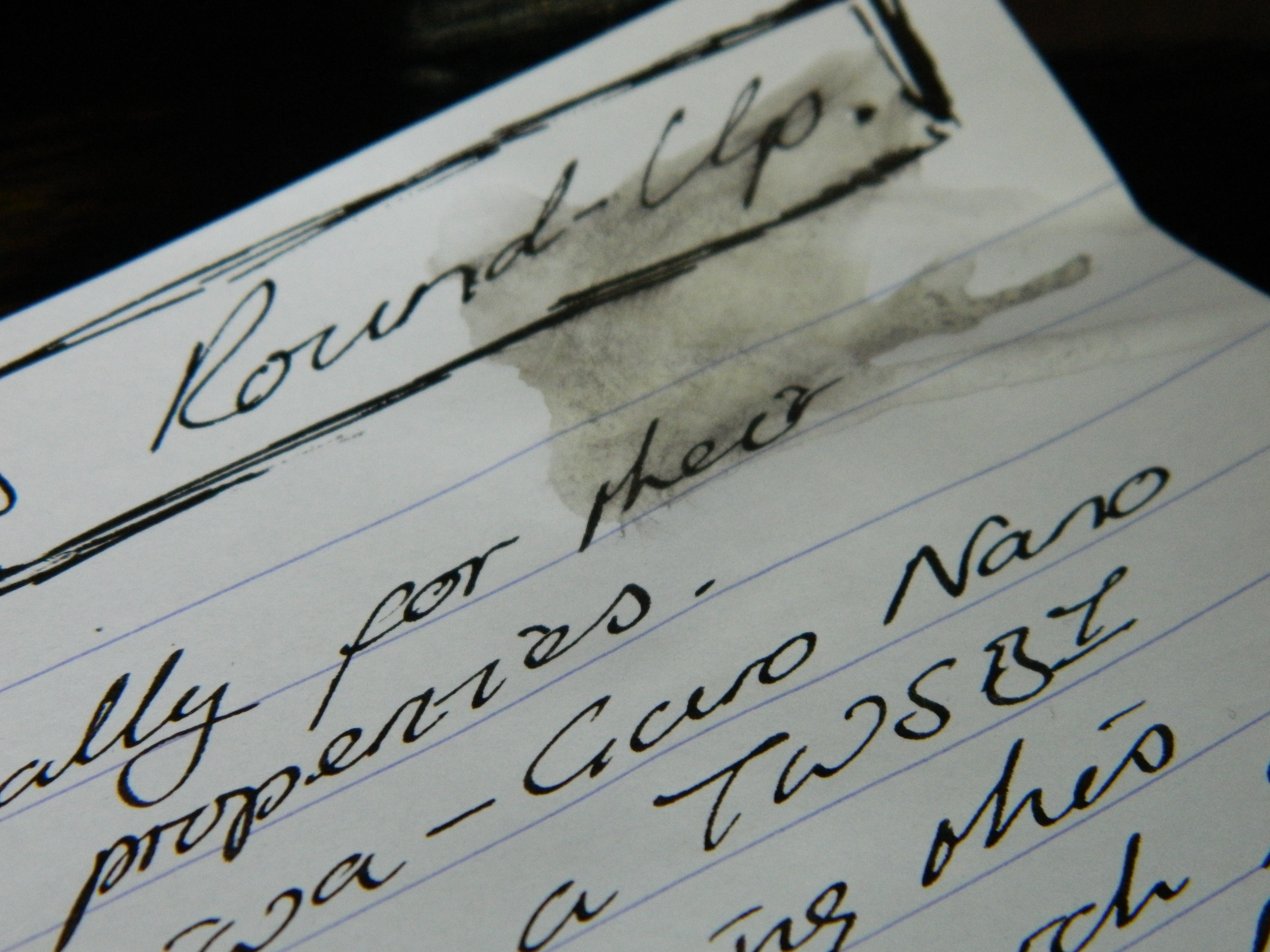 The Sailor Kiwa-Guro Nano, is definitely a water-resistant ink, rather than the waterproof that I wanted. This is my fault really, specifications and descriptions on the product pages of retailers for this ink mostly specify resistance. I just read a few amateur reviews, that mostly raved about it being a great black ink, and slipped up. Don’t get me wrong, it is a great black ink, and it’s tone, flow and performance in other areas is excellent. It’s just not waterproof, and that’s what I wanted; my bad. I think my next port of call will be Noodler’s Bad Black Moccasin, or maybe Platinum’s Carbon Black—both of which are considerably cheaper, but I’ll finish this bottle before I buy any more.
The Sailor Kiwa-Guro Nano, is definitely a water-resistant ink, rather than the waterproof that I wanted. This is my fault really, specifications and descriptions on the product pages of retailers for this ink mostly specify resistance. I just read a few amateur reviews, that mostly raved about it being a great black ink, and slipped up. Don’t get me wrong, it is a great black ink, and it’s tone, flow and performance in other areas is excellent. It’s just not waterproof, and that’s what I wanted; my bad. I think my next port of call will be Noodler’s Bad Black Moccasin, or maybe Platinum’s Carbon Black—both of which are considerably cheaper, but I’ll finish this bottle before I buy any more.
—Platinum Pigment Blue
This did really well.
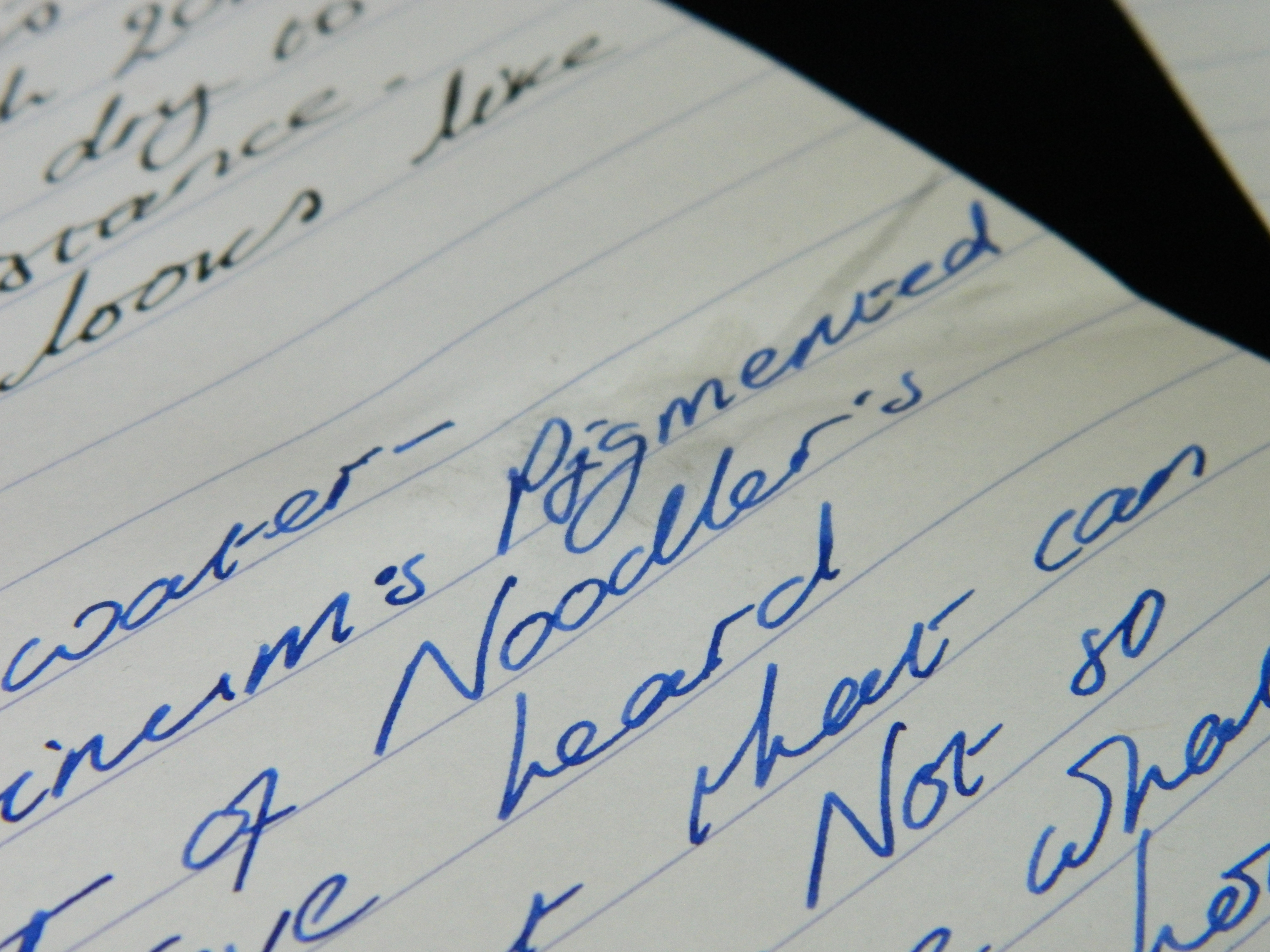 As you can see, there is almost no disturbance of the ink at all.
As you can see, there is almost no disturbance of the ink at all.
 What little disturbance there is, is mostly due to me smearing the water with my fingertip, rather than just letting it affect the ink.
What little disturbance there is, is mostly due to me smearing the water with my fingertip, rather than just letting it affect the ink.
The ink is a great performer, running wet and juicy in any pen and nib combination I care to give it, and the color of that blue is everything I want in a blue ink.
—Noodler’s #41 Brown
Similarly, Noodler’s #41 behaved beautifully. It’s a rich, mid-brown, slightly heavier/deeper than the Golden Brown, and much wetter. Subjective impressions have left me thinking that it’s not quick to dry, and takes a while before it bonds with the paper sufficiently to be called waterproof, but when it does…
Once again, there is some minor disturbance of the ink. A little smudging is evident…
… but everything is still legible, and only very slightly altered by my smearing the water into the writing sample.
—Noodler’s Golden Brown
This is another one of my favorite inks, which has fallen a little out of favor recently. Until a week or so ago, I used this ink in a TWSBI with a broad nib, and it was very nice indeed. Then I tried it in my Sailor Pro Gear Slim Special Edition Earth. The Sailor just didn’t like it at all. The ink flowed fine through a juicy broad TWSBI nib, but in the Japanese broad-that-writes-like-a-medium, it was another matter, and I had to move the Sailor onto the far wetter Diamine Chocolate Brown. But back in a TWSBI Eco, Noodler’s Golden Brown behaves just as it should, and that means being only resistant to water.
And, as can be seen from the close-up of the writing sample, it doesn’t resist particularly hard either.
—Diamine Chocolate Brown
Until now, I have been pretty hard on some inks that claim water-resistance, but may not be as resistant as I would like them to be. These last two samples give you an idea of what an ink is like that has pretty much zero water-resistance, and to be fair, has never claimed to have.
Diamine’s Chocolate Brown can simply be washed away, with very little trace of it ever having been there. Don’t use this one for writing cheques ladies and gentlemen.
I Like this ink all the same; it’s a beautiful, deep, rich brown, that looks stunning against the backdrop of cream Tomoe River writing paper. And it’s worth mentioning that it’s a very wet ink, and quite capable of breathing some life into a dry old nib and feed if necessary. This one will definitely be a preferred indoor ink.
And lastly…
—Diamine Shimmertastic Lilac Satin
This is another ink that nobody should use for writing their last will and testament. A couple of drops of water on this, and nobody would ever guess you’d written anything…
This is another great color, and I keep it around for the sheer entertainment value, but I wouldn’t use this for writing, or signing anything of any consequence. And as attractive as it is, I wouldn’t even use it for addressing a few birthday party invites.
If it’s raining on the day of delivery, there’s a good chance the address’ll wash clean off!
Summary
Platinum’s Pigmented Blue, and Noodler’s #41 Brown, absolutely lived up to  their water-resistant claims. After 8 hours, they were completely solid on the page, and a few drops of dihydrogen monoxide disturbed them in no way whatsoever. The same could not be said for the expensive Sailor ink (more than three times as expensive per ml, as the Noodler’s), and as much as I like that Sailor ink, it’s black, and there are plenty more black inks out there that actually have the features I want. I just have to buy a few and do some experimenting; I already seem to have a willing laboratory assistant… now where did I put that old lab’ coat?
their water-resistant claims. After 8 hours, they were completely solid on the page, and a few drops of dihydrogen monoxide disturbed them in no way whatsoever. The same could not be said for the expensive Sailor ink (more than three times as expensive per ml, as the Noodler’s), and as much as I like that Sailor ink, it’s black, and there are plenty more black inks out there that actually have the features I want. I just have to buy a few and do some experimenting; I already seem to have a willing laboratory assistant… now where did I put that old lab’ coat?
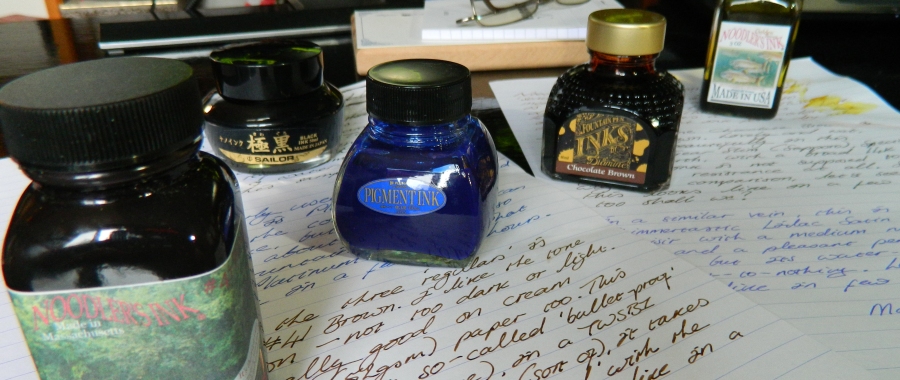

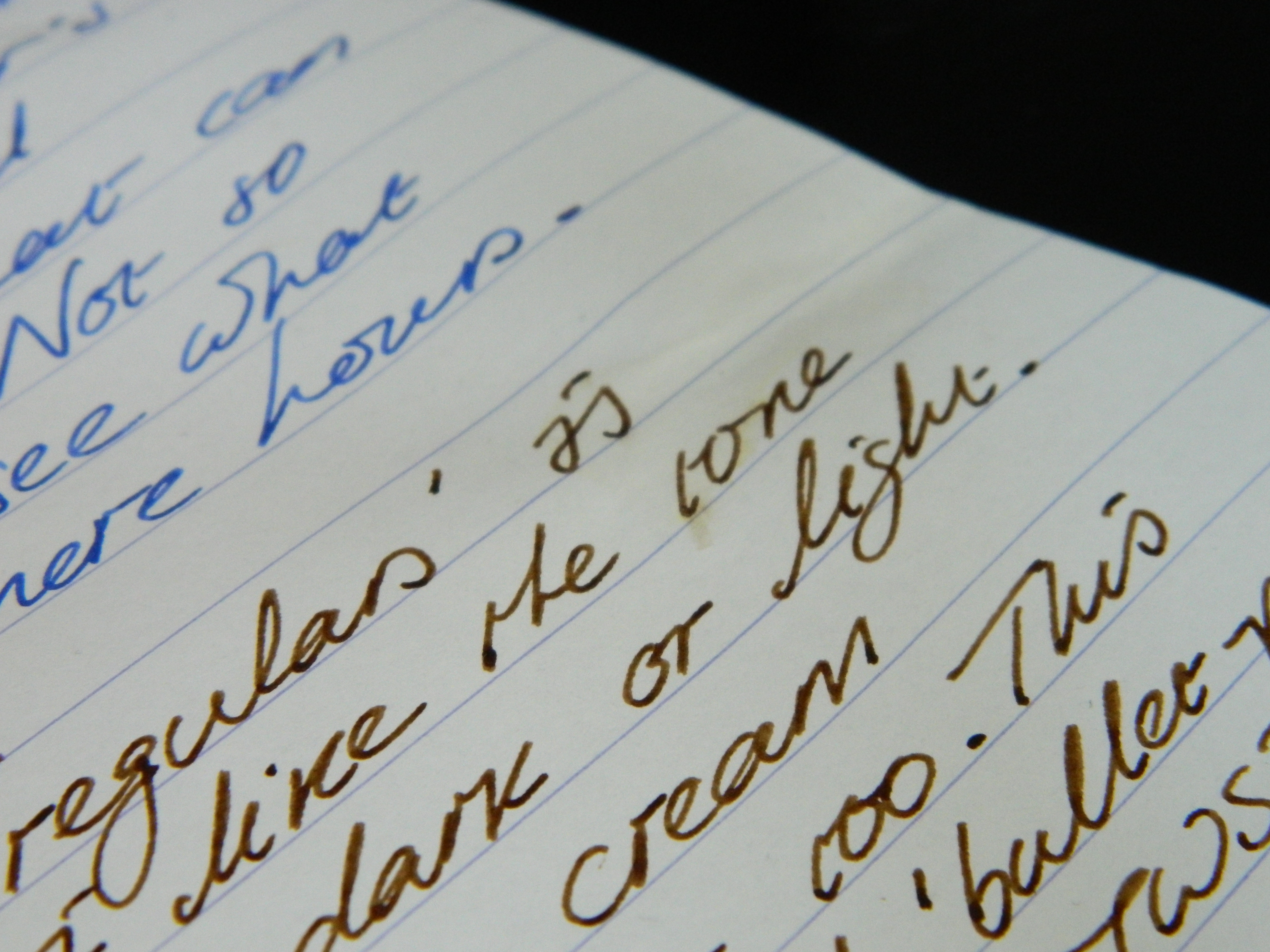

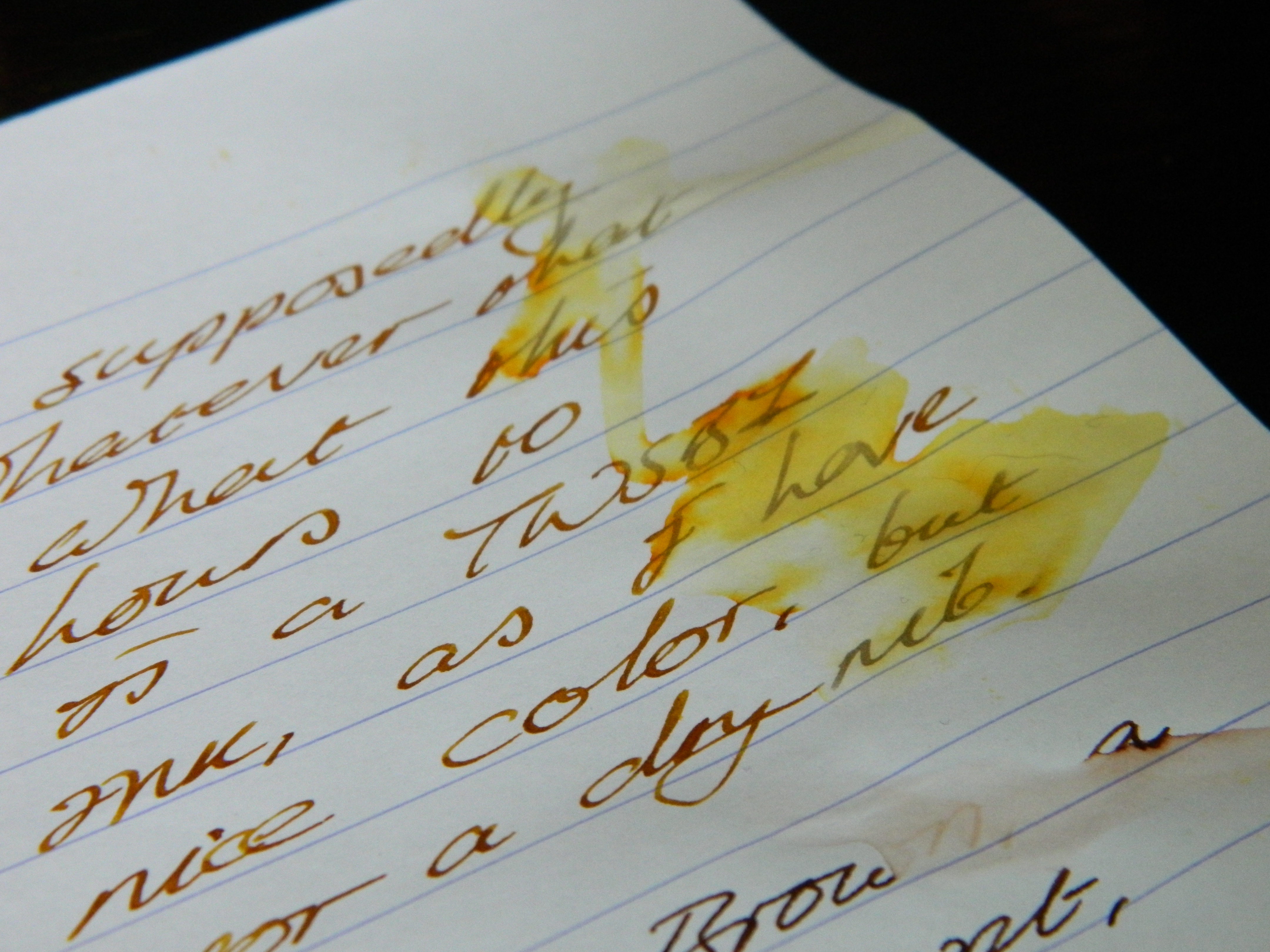


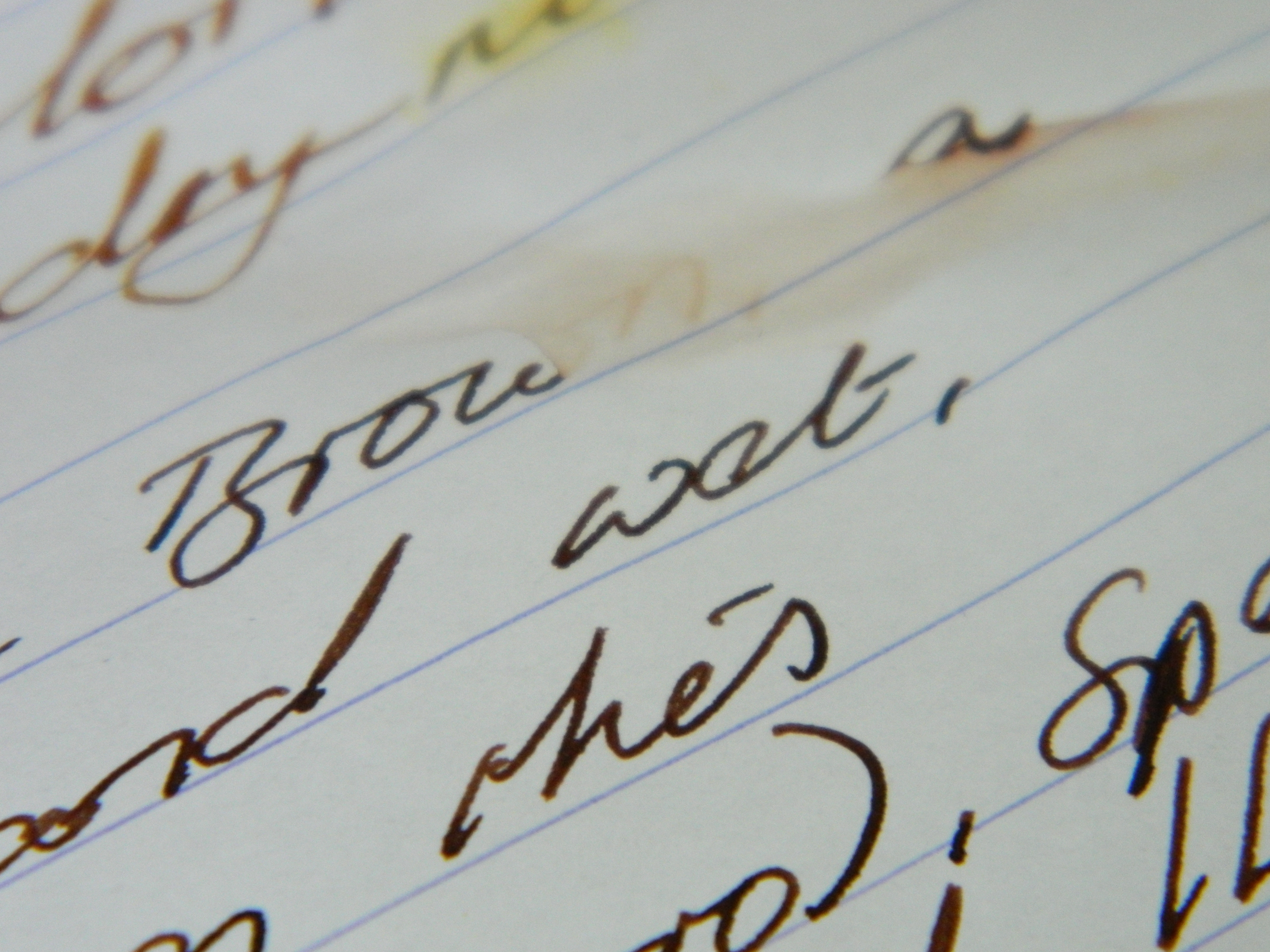
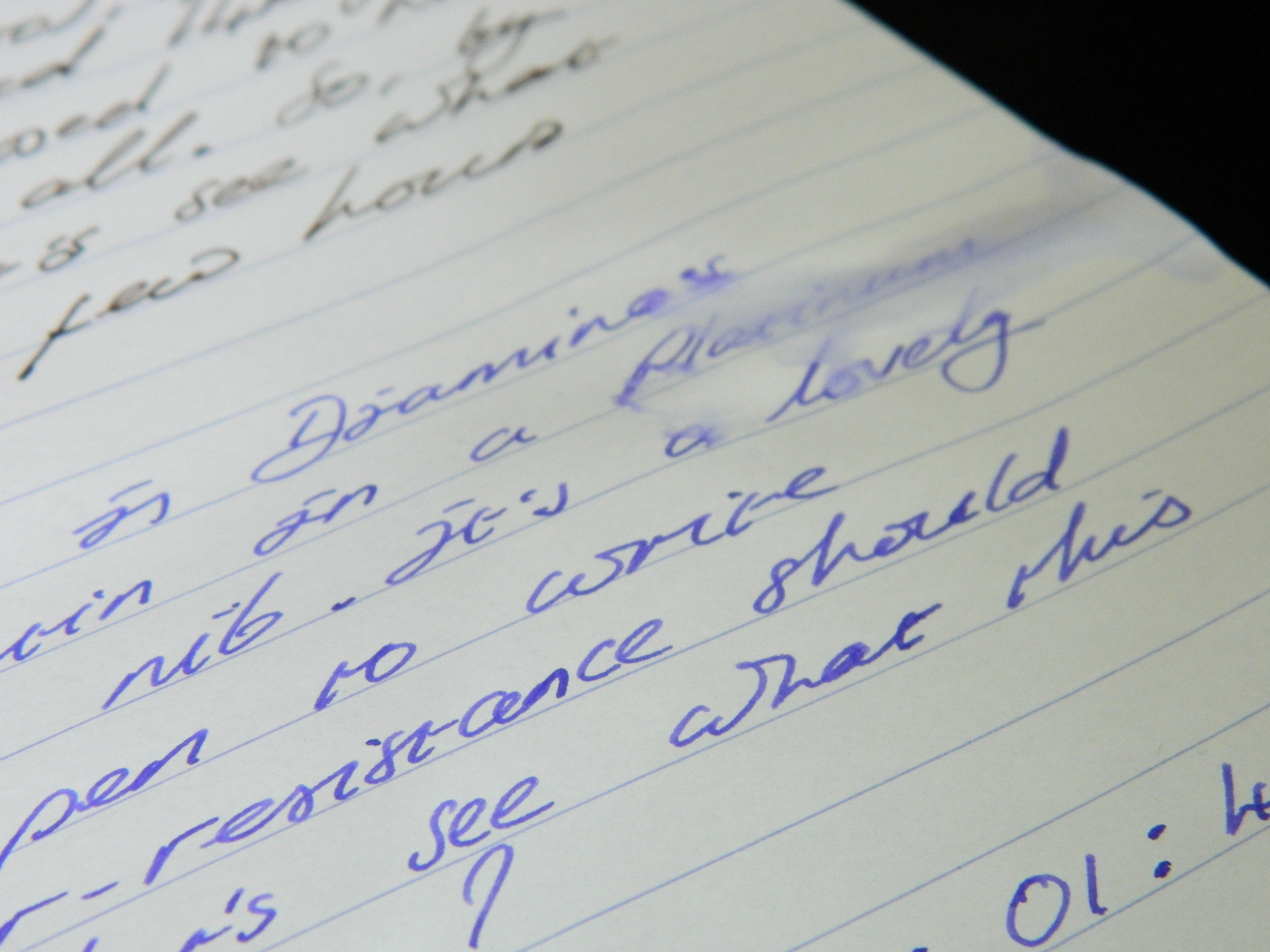

I love the scientific method presented here, but should the fingertip size or smearing gesture be quantified?
Also, it’s ain’t. (I say this not to be a know-it-all, because in truth I know very little, it’s just that I want your post to look better, because I like reading your posts.)
LikeLiked by 1 person
Ain’t—typo’ honest! It’ll be changed ASAP!
LikeLike
I’m sure it’s your cat’s fault anyway, distracting you at an important moment.
LikeLiked by 1 person
That’d be it, in fact, he wrote the whole thing using the touchscreen method above.
LikeLike
Wow, literate AND adorable
LikeLiked by 2 people
Who? Me or the cat?
LikeLiked by 2 people
I’ll let you fight that one out between you two. Let me know how it goes!
LikeLiked by 1 person
A thought provoking piece. Do I need my ink to bond with paper or with kit and kin? One person’s “non-water resistant” is another (clumsy) person’s (me) “phew, it’s washable.”
I like the scientific method and the lab assistant.
LikeLiked by 1 person
Ah, now washable is a whole different question. 😖
LikeLike
Oh….so, um, what colour was Alfie, you know, before…..
LikeLiked by 2 people
Ha! Yeah, he was a ginger tabby 😂
LikeLike
That’s explains a lot 🙂
LikeLiked by 1 person
“Never allow children or cats…within a 10 meter radius of an open bottle of ink.”
Or people like me. Sigh. I’m at least as likely to tip over a bottle of ink as my children. Then again, I am far more likely to be messing about with a bottle of ink, so maybe I’ve just enjoyed more opportunities. I have a particular talent for toppling the most staining of liquids, though.
I avoid waterproof inks because I’m:
1) Not good enough at cleaning my pens, and
2) Likely to wear some of my ink. Always. Every freakin’ time.
I used to keep one pen with a more permanent ink for signatures when I was working and signing off on a lot of documents, but I always made it a cheap pen. I would have no use for permanent black ink, though, as I believe signatures (my main use) must be in a color that isn’t the same as a b&w photocopy.
This was usually blue at work, because I can be oddly traditional in very select circumstances, but would be purple if I were signing things for more personal reasons, like if I got really famous and everyone wanted my autograph. Which could happen any day now, I’m sure.
I always address my envelopes using a Sharpie, and I feel a little sad about it every time when I put down my lovely fountain pen and begin scratching at my nice paper with a stupid felt tip. It gets my letters to the addressee, however, and matches my rationale of using my best cursive handwriting for the missive itself, but postal service approved block capitals on the envelope.
LikeLiked by 1 person
Good, solid reasoning… ref. wearing the ink a few years ago, that was called tie-dye, and was highly fashionable I seem to remember. I have a t-shirt as evidence, and I get admiring glances whenever I wear it (I think). Just you wait, in a couple of years they’ll be back in fashion, and we could team-up for a fashion blog!
LikeLiked by 1 person
Have you tried Noodlers Bulletproof black and Platinum Carbon black?
LikeLike
Thank you Cheryl! I haven’t tried them, but they are on my shortlist. Have you got some experience of them? Would they pass the Face-Down-in-the-Bath-Test? 🙂
LikeLike
Yes I have . I use them for my sketches. Never heard of the Face-Down-in-the-Bath-Test before I read your post but almost every day they get a good wash and swash of watercolour. They dry in seconds and stay put. DeAtramentis Document inks are waterproof too (the DOCUMENT inks not the regular ones). I use their Brown. I also use the Noodlers #41 Brown (you know about this one) and Noodlers Lexington Grey – they too dry in seconds and sat put when I add water/watercolour to my sketches..
LikeLiked by 1 person
Thanks… unfortunately, the Bath Test involved a notebook, a child and a cat, so it’s pretty difficult to reproduce anyway. I’m seriously interested in Noodler’s bulletproof inks, so I’ll be giving your recommendations a try, thanks again!
LikeLike
My pleasure.
LikeLiked by 1 person
Pingback: This week in faking the writing part – Writing